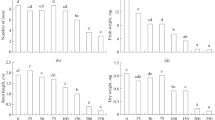Abstract
The structural organization of roots, induced in the callus cultures of barley genotypes differing in aluminum tolerance: cv Kupetz, cv 999-93 and its somaclonal form R 999-93 was studied. The goal of this research was to determine how the toxic effects of aluminum at low pH affects the structure of the root and any cells damage of different tissues meristematic zone. At pH 5.8–6.0 root callus from different genotypes had specific features, manifested in the structure root cap, the epidermis, the form of roots. In the presence of 40 mg/1 Al3+ ions and pH 3.7–3.8 in the roots, callus was obtained from the cv Kupetz, there is strong damage to the epidermis, root cap and some other tissues, which, although and resulted in the death of cells, however, were not lethal character. In roots, callus derived from varieties 999-93, under the influence Al3+ ions was observed irreversible changes that lead either to compaction cytoplasm and nuclei, especially in the central part of the root or to the plasmolysis and the destruction of cells, especially in the meristematic zone. On transverse sections was found damaged cells of the central part of the root, formation of the densified outer cell wall of epidermal cells. At the investigation of R 999-93 callus roots it was be shown that most of the cells of meristematic zone of root retained their viability at influence of Al3+ ions. So, the somaclon from cv 999-93, obtained earlier in callus culture by selection on Al-tolerance, differs from the original form at the level of mesostructure.
Similar content being viewed by others
References
Klimashevsky, E.L., Genetic Aspects of Mineral Nutrition of Plants, M.: Agropromizdat, 1991, p. 415.
Kochian, L.V., Hoekenga, O.A., and Pineros, M.A., How do Crop Plans Tolerate Acid Soils? Mechanisms of Aluminum Tolerance and Phosphorous Efficiency, Ann. Rev. Plant Biol., 2004, vol. 55, pp. 459–493.
Kochian, L.V., Cellular Mechanisms of Aluminum Toxicity and Resistance Plants, Ann. Rev. Plant Biol., 1995, vol. 46, pp. 237–260.
Wang, J.-P., Raman, H., Zhang, G.-P., Mendham, N., and Zhou, M.-X., Aluminium Tolerance in Barley (Hordeum vulgare L.): Physiological Mechanisms, Genetics and Screening Methods, J. Zhejiang Univ. SCIENCE B, 2006, vol. 7, no. 10, pp. 769–787.
Gulevich, A.A., Baranova, E.N., Polyakov, V.Yu., and Kharchenko, P.N., Ultrastructural Evaluation of Possible Results of Cell Selection of Medicago sativa for NaCl, Rus. Agric. Sci., 2010, vol. 36, no. 2, pp. 100–104.
Baranova, E.N., Gulevich, A.A., Polyakov, V.Yu., and Kharchenko, P.N., Comparative Analysis of Anatomic Structure of Cotyledons for Determining Salt and Osmotic Tolerance of Modified Plants, Rus. Agric. Sci., 2007, vol. 33, no. 4, pp. 236–238.
Gendrel, A.-V. and Colot, V., Arabidopsis Epigenetics: when RNA Meets Chromatin, Cur. Opin. Plant Biol., 2005, vol. 8, no. 2, pp. 142–147.
Vnuchkova, V.A., Nettevich, E.D., Chebotareva, T.M., Khitrova, L.M., and Molchanova, L.M., Application of in vitro Methods in Barley Breeding on Resistance to Acid Soils Toxicity, Dokl. VASKhNIL, 1989, no. 7, pp. 2–5.
Conner, A.J. and Meredith, C.P., Large Scale Selection of Aluminum-Resistant Mutants from Plant Cell Culture: Expression and Inheritance in Seedlings, Theor. Appl. Genet., 1985, vol. 71, pp. 159–165.
Muyuan, Y., Zhu, J., Pan, L., Wang, Q., and Gua, C.H., Mutation Induced Enhancement of Al Tolerance in Barley Cell Lines, Plant Sci., 2003, vol. 164, pp. 17–23.
Zobova, N.V., Lugovtzova, S.Y., and Konysheva, E.N., Application of Biotechnology at Creation of Cultivars Tolerant to Edaphic Stress, Sib. Vestnik S.-Kh nauk, 2003, no. 2, pp. 44–48.
Shirokikh, I.G., Ogorodnikova, S.Yu., Dal’ke, I.V., and Shuplechova, O.N., Physiological and Biochemical Indices and Productivity of Barley Plants Regenerated from Callus in Selective Systems, Rus. Agric. Sci., 2011, vol. 37, no. 2, pp. 98–102.
Shirokikh, I.G., Shuplechova, O.N., and Schennikova, I.N., In Vitro Production of Barley Forms Resistant to the Toxic Effect of Aluminum in Acid Soils, Biotekhnologiya, 2009, no. 3, pp. 40–48.
Baranova, E.N., Gulevich, A.A., and Lavrova, N.V., Effect of Acid pH on Structural Organization of Nuclei and Nucleoli of Root and Apical Meristem Cells of Wheat During Germination, Izvestia of Timiryazev Agricultural Academy, 2010, no. 2, pp. 44–51.
Author information
Authors and Affiliations
Corresponding author
Additional information
The article is published in the original.
About this article
Cite this article
Baranova, E.N., Bakulina, A.V., Shirokikh, I.G. et al. The influence of aluminium on the structural organization of the roots of barley in culture in Vitro . Russ. Agricult. Sci. 37, 358–363 (2011). https://doi.org/10.3103/S1068367411050065
Published:
Issue Date:
DOI: https://doi.org/10.3103/S1068367411050065




